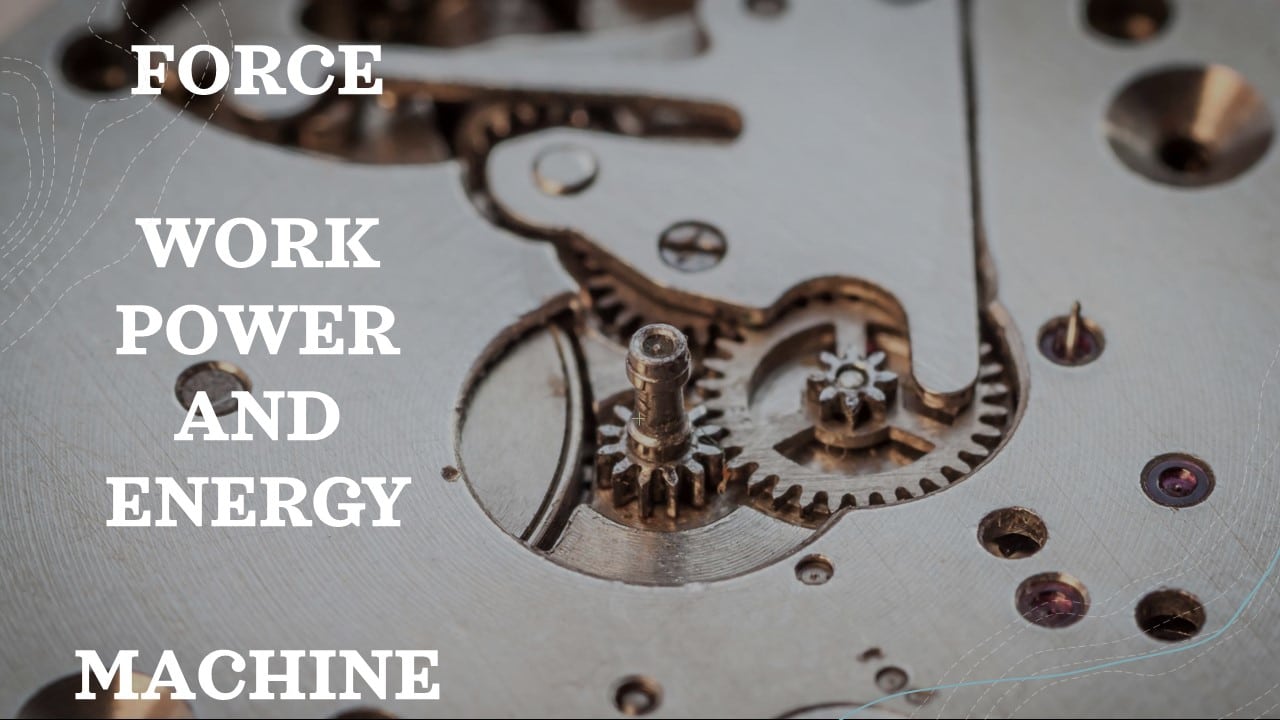STD X – FORCE, WORK, POWER AND ENERGY – EINSTEIN
About Course
In this Section we will Learn the following Chapters
1. Force
2. Work, Power and Energy
3. Machines
Last Updated:July 9, 2025
0 (0 Ratings)
Share Course
Page Link
Share on social media

Description
FORCE
A Force is that physical cause which changes or tends to change either the size or shape or the state of rest or motion of the body.
From the point of view of an application, they are 2 types, Contact and Non-Contact forces. SI Unit of Force – Kg ms-2 or N (Newton).
Contact Forces | Non-Contact Forces
Frictional Force | Normal Reaction Force | Tension Force | Spring Force
Gravitational Forces | Electrostatic Force | Magnetic Force
Uniform Circular Motion
The movement of an object in a circular path, with a constant speed, is known as uniform circular motion.
A bike moving around a circular path is in a circular motion. The bike moving in a circular path with uniform speed is known as uniform circular motion.
Circular Motion
Motion of an object along a circular path.
Circular motion is an accelerated motion because the direction of the velocity changes continuously.
If a body moves on a circular path with uniform speed, it is called uniform circular motion.
The acceleration of this body is known as centripetal Acceleration which is directed towards the center of the circle.
WORK POWER AND ENERGY
Everyday meaning of work is some activity that requires physical or mental effort. But according to physics, the definition of work is more precise and unambiguous. In Physics, if a force displaces an object, the work is said to be done.
The SI unit of work done = Newton(N) X metre(m) = joule(J)Energy is the capacity to do work. Energy is the cause and work is an effect. Therefore both work and energy have the same units, which is joule (J) in the SI system and erg in the CGS system. Kinetic energy and potential energy are the two main types of energy.
Power is the work done in a unit of time. In other words, power is a measure of how quickly work can be done.
MACHINES
Simple machines can be regarded as the elementary “building blocks” of which all more complicated machines are composed. They can be defined as the simplest mechanisms that use mechanical advantage (also called leverage) to multiply force.
Inclined Plane
An inclined plane is a sloping surface that behaves like a simple machine whose mechanical advantage is always greater than 1.
Pulley
A Pulley is one of the original simple machines.
The original primary use for pulleys was to make it easier to lift heavy items. A pulley is a simple machine made with a wheel and a rope, cord, or chain.
Pulleys can be found everywhere, helping us in making our tasks easier. In addition to lifting things, pulleys can be used singly or with many pulleys working together in order to transport people or things.
Single fixed pulley | Single movable pulley | Combination of pulleys | Block and tackle system
Levers
The axis, about which the lever turns, passes through a point of the lever which is called the fulcrum (F)
This point does not move, but remains fixed when the lever is in use
A lever is a rigid, straight or bent bar which is capable of turning about a fixed axis
Principle of lever
Moment of load about fulcrum = moment of effort about fulcrum
What I will learn?
- Force and motion are important parts of everyday life
- Force can make a body that is at rest to move so practically all movements is a result of some form of force
- Machines are a part of our everyday life, In fact our body is a machine made of levers
- Movement of parts of machines helps garner practical knowledge
Free
Free
Free access this course
-
LevelIntermediate
-
Total Enrolled7
-
Duration10 hours 30 minutes
-
Last UpdatedJuly 9, 2025
Hi, Welcome back!
Material Includes
- 🔥 Live Interactive classes with in-class doubt solving
- ⭐ Weekly Test and Quiz with instant tracking for progress
- ⚙️ Revision of the course after testing
- 👋 Fortnightly Parents and Tutor interactions
- 🌷 Expert monitoring of student's learning progress
- 👨👩👧👧 Daily communication over call, whatsapp and mail
- 💻3 hours on-demand video
- ✍4 downloadable resources
- ⌛Access for entire Academic Year
- 📱Access on mobile and Desktop
- 📋Assignments and review of the same
- 💡Tests and Correction by Board paper checkers
- 🏅Certificate of completion and Live tracking with Grade book
Course Duration:
10h 30m
Course level:Intermediate
Enrolled:7
About Course
In this Section we will Learn the following Chapters
1. Force
2. Work, Power and Energy
3. Machines
What I will learn?
- Force and motion are important parts of everyday life
- Force can make a body that is at rest to move so practically all movements is a result of some form of force
- Machines are a part of our everyday life, In fact our body is a machine made of levers
- Movement of parts of machines helps garner practical knowledge
Course Curriculum
FORCE – 11 MARCH 2023 – MOMENT OF FORCE, COUPLE
-
FORCE – PHYSICAL CLASS – 11032023 – INTRODUCTION TO TERMS
23:23 -
FORCE – CORE CONCEPT – MOMENT OF FORCE
13:03 -
FORCE – CORE CONCEPT – COUPLE AND MOMENT OF COUPLE
04:12 -
FORCE – CORE CONCEPT – PRINCIPAL OF MOMENTS
07:13 -
FORCE – PHYSICAL CLASS – 11032023 – MOVEMENT OF COUPLE
21:36 -
FORCE – PHYSICAL CLASS – 11032023 – DEMOSTRATION OF COUPLE
02:37 -
FORCE – CORE CONCEPT – EQUILIBRIUM
03:43 -
FORCE – SUPPORT MATERIAL – MOMENT OF FORCE, EQUILIBRIUM
06:00 -
FORCE – PHYSICAL CLASS – 11032023 – NUMERICALS BASED ON COUPLE
13:04 -
FORCE – PHYSICAL CLASS – 11032023 – NUMERICALS BASED ON MOVEMENT OF FORCE
23:11
FORCE – 18 MARCH 2023 – CENTRE OF GRAVITY AND UNIFORM CIRCULAR MOTION
Moment of Force and equilibrium
Principle of Moment
Centre of Gravity
Uniform Circular Motion
Translational and Rotational motion
Torque
Clockwise and Anticlockwise rotation
Principle of Moment
-
FORCE – CORE CONCEPT – CENTRE OF GRAVITY
12:34 -
FORCE – SUPPORT MATERIAL – CENTRE OF GRAVITY
06:00 -
FORCE – CORE CONCEPT – CENTRIFUGAL AND CENTRIPETAL FORCE
15:17 -
FORCE – SUPPORT MATERIAL – UNIFORM CIRCULAR MOTION
06:00 -
FORCE – PHYSICAL CLASS – 11032023 – DEMOSTRATION OF COUPLE
02:37 -
UNIFORM CIRCULAR MOTION – PHYSICAL CLASS – CENTRIPETAL AND CENTRIFUNGAL FORCE
24:13 -
FORCE – PHYSICAL CLASS – CENTER OF GRAVITY
22:12 -
FORCE – PHYSICAL CLASS – METER RULE NUMERICALS
07:19
WORK,POWER AND ENERGY – 25 MARCH – WORK AND POWER
-
WORK POWER AND ENERGY – CORE CONCEPT – CONVERSION OF ENERGY FROM
12:51 -
WORK POWER AND ENERGY – CORE CONCEPT – POTENTIAL ENERGY
09:00 -
WORK, POWER AND ENERGY – PHYSICAL CLASS – WORK AND UNITS
10:51 -
WORK POWER AND ENERGY- CORE CONCEPT – KINETIC ENERGY
06:14 -
WORK AND POWER – CORE CONCEPT – WORK AND POWER
19:20 -
WORK, POWER AND ENERGY – PHYSICAL CLASS – MAGNITUDE AND DIRECTION OF WORK DONE
18:50 -
WORK, POWER AND ENERGY – PHYSICAL CLASS – POWER AND ITS UNITS
05:30 -
WORK POWER ENERGY – SUPPORT MATERIAL- WORK AND ENERGY
05:00
WORK POWER ENERGY – 01 MARCH – INTERCOVER OF ENERGY AND WORK ENERGY THEOREM
-
WORK, POWER AND ENERGY – PHYSICAL CLASS – INTRODUCTION TO ENERGY
04:07 -
WORK POWER ENERGY – PHYSICAL CLASS – CONVERTION OF ENERGY
12:05 -
WORK POWER ENERGY – PHYSICAL CLASS – DIFFERENTS TYPES OF ENERGY
19:38 -
WORK POWER AND ENERGY – CORE CONCEPT – DIFFERENT FORMS OF ENERGY
09:58 -
WORK POWER ENERGY – PHYSICAL CLASS – EXPRESSION FOR KINETIC ENERGY
07:47 -
WORK POWER AND ENERGY – CORE CONCEPT – WORK-ENERGY THEOREM
06:23 -
WORK POWER ENERGY – PHYSICAL CLASS – TYPES OF MECHANICAL ENERGY
09:37 -
WORK POWER ENERGY – PHYSICAL CLASS – TYPES OF KINETIC ENERGY, WORK ENERGY THEOREM
14:25 -
WORK POWER ENERGY – SUPPORT MATERIAL – TYPES OF ENERGY
06:00
WORK POWER ENERGY – 08 – APRIL – BASED ON NUMERICALS
-
WORK POWER AND ENERGY – PHYSICAL CLASS – NUMERICAL BASED ON WORK POWER – PART II
22:58 -
WORK POWER AND ENERGY – PHYSICAL CLASS – NUMERICAL BASED ON WORK POWER
20:42
WORK POWER ENERGY – 22 – APRIL – BASED ON NUMERICALS
-
WORK POWER AND ENERGY – PHYSICAL CLASS – NUMERICALS BASED ON INTERCONVERSION OF ENERGY PART I
11:37 -
WORK POWER AND ENERGY – PHYSICAL CLASS – NUMERICALS BASED ON INTERCONVERSION OF ENERGY PART II
03:11 -
FORCE, WORK, POWER AND ENERGY – PHYSICAL CLASS – NUMERICALS – I
13:53 -
FORCE, WORK, POWER AND ENERGY – PHYSICAL CLASS – NUMERICALS – II
08:03 -
FORCE, WORK, POWER AND ENERGY – PHYSICAL CLASS – NUMERICALS – III
07:52
MACHINES 29 – APRIL – INTRODUCTION TO MACHINE, LEVER PULLY
Machines - technical terms and levers
Relationship between Efficiency, Mechanical Advantage and Velocity ratio
Kind of levers
PULLEY
Single fixed
Single movable
Block and tackle
-
MACHINES – CORE CONCEPT – INTRODUCTION
03:07 -
MACHINE – PHYSICAL CLASS – SIMPLE MACHINE INTRODUCTION
22:01 -
MACHINE – PHYSICAL CLASS – SIMPLE MACHINE RELATION BETWEEN EFFICIENCY, M A , V R
05:41 -
MACHINE – PHYSICAL CLASS – TYPES OF LEVER
22:08 -
MACHINES – CORE CONCEPT – TECHNICAL TERMS
13:05 -
MACHINES – SUPPORT MATERIAL – LEVERS
05:00
MACHINE – 06 MAY – INTRODUCTION OF PULLEY – SINGLE FIXED PULLEY
-
MACHINE – PHYSICAL CLASS – INTRODUCTION OF PULLEY – SINGLE FIXED PULLEY
21:44 -
MACHINES – CORE CONCEPT – PULLEYS
28:22 -
MACHINES – SUPPORT MATERIAL – PULLEY
06:00
Student Ratings & Reviews

No Review Yet

